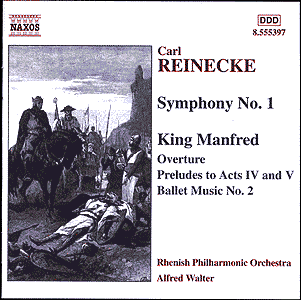|
Carl REINECKE (1824-1910) Crotchet
AmazonUK AmazonUS |
 |
Carl Reinecke is often remembered for the cadenzas that he wrote to other composers' classic concertos rather than for his own compositions. He was, however, a prolific writer of around 300 works. He was born at Altona near Hamburg, the son of a teacher of music. At 11 he made his debut as a violinist and at 12 made his first public appearance as a pianist. Later, he toured North Germany as a pianist and this led to his appointment as court pianist in Denmark (for two years) before turning to the education of others.
In 1851 Hiller invited him to join the staff of the Cologne Music School where he worked for the next three years. On the recommendation of Hiller and Gade Reinecke was appointed director of the Gewandhaus concerts in Leipzig and became professor of piano and composition at the Conservatorium there. As a friend of Mendelssohn, Brahms and Schumann he devoted much of his time to performances of their music whilst, as a pianist, he had a reputation as an interpreter of Mozart.
Reinecke's Symphony No. 1 began with sketches made five years earlier in 1858. It underwent some rewriting before being performed in Leipzig under the composer's direction in October 1863. Its structure follows a similar pattern to Haydn's symphonies but in orchestration has leanings towards Mendelssohn with melody and harmony more in line, as one might expect, with Gade and Schumann. The first movement, in romantic sonata form, starts with a ponderous opening (Lento) but gathers momentum to open into an Allegro con brio where the orchestral forces majestically herald a stirring main subject of soaring strings with Mendelssohnian overtones. A tranquil Andante follows of five-section rondo form. A thread of melancholy weaves through it with a theme of innocence (typical of Reinecke and strongly reminiscent of Mahler's Adagietto from his 5th symphony). A chromatic passage later gives a clear hint of Schumann. A Scherzo provides contrast with the previous movement with its strong opening rhythm and cheery character. This then relaxes into a flowing melodic line before breaking into the sprightly opening. The Finale, again in sonata form, an Allegro ma non troppo with short development leads to an Allegro molto quasi presto which provides us with a bright and technically proficient conclusion.
King Manfred was written as a 5 Act Romantic Grand Opera to libretto by Roeber. The opera concerns the fate of King Manfred of Sicily who fell in battle against Charles at Anjou. The heavy subject matter caused the opera to disappear from general repertoire (despite being published) but its Overture and the Preludes were to be heard in concert halls up to the turn of the century. The Overture is one of Reinecke's most important works. In it he replaces the musical content of the opera's score with a character-sketch of Manfred in the manner of Beethoven's Leonora or Wagner's Faust. One is aware of lyrical melodies for horn and cello, the strumming of a minstrel's harp against a romantic theme and brass fanfares to herald the presence of powerful armies. The Prelude to Act IV is particularly atmospheric with solo violin playing a theme with legato harp and orchestral background. The Prelude to Act V opens with a short introduction to anticipate a darkness of impending catastrophe, that marking the death of Manfred. A lyrical passage brings a release from tension and presumably is used to make us aware of the good qualities of this King. The Ballet Music was included to meet French rather than German tradition. It comprises two numbers. Without a synopsis this piece is difficult to comment on. The pace of the first slow and lifeless number tends to drag and one wonders if its metronome marking has been accurately read. The second number is a bright and stirring dance more in keeping with the Slovaks than the Italians (despite a touch of Grieg here and there).The performances of the two works are excellent and the recording is well balanced. The Rhenish Philharmonic Orchestra plays with energy and competence under the fine direction of Alfred Walter. The notes give fair detail of composer and a short section on the works.
This disc is one of a series first released on their more expensive Marco Polo label which is now transferred to the more accessible Naxos label. Marco Polo's philosophy was to provide good performances of rarer works by lesser-known orchestras under knowledgeable conductors. The transfer of label makes them now available at a very affordable price.
Raymond Walker